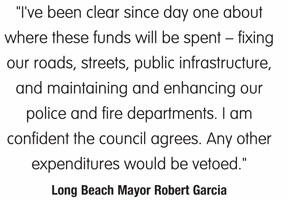The sales tax measure on the June 7 ballot may come down to a single word: trust. Do voters trust the nine city councilmembers – the only people who get to vote on how taxpayer money is spent – to take the estimated $384 million that the measure generates over a 10-year period and spend it exclusively on public safety and infrastructure needs? It’s a legitimate question.
Mayor Robert Garcia has stated that he would veto any effort to spend money on items other than for public safety or infrastructure. Many people trust him. But, because of the city’s district election system, most voters do not know eight of the nine councilmembers who decide on issues impacting the day-to-day lives of every resident and every business owner. Heck, as evidenced by the low voter turnout, residents may not know their own district representative. This lack of engagement with councilmembers presents trust issues, as does the fact that many councilmembers are beholden to unions, whose members are openly saying they’re looking for pay raises.
Even without the trust issue, many people are questioning the need for the tax. Why do we need more police officers, firefighters or equipment? Is our infrastructure really that bad or is it a way to hide salary increases? Why is relocating fire stations necessary? These, too, are legitimate questions.

So the Business Journal staff sought out more information to understand the issues and the impacts to quality of life for Long Beach residents. We learned, from lengthy interviews with city staff, that money is indeed necessary to improve public safety and to repair the city. As you’ll read in this edition, violent and property crime is up significantly. The response time to a fire or medical emergency is considerably below national standards. The longer we wait to repair our streets, sidewalks, alleys, bridges, etc., the less safe and the more expensive they become.
Voters have two questions they need to ask themselves. One, if the measure fails, what then? The needs do not go away. Two, what type of city do they want to live in?
Before making up your mind to support the tax or not, we encourage you to read the articles here and examine the tables and charts presented in this edition.
About The Sales Tax Measure
The tax measure has two components. First, it raises the city’s sales tax from its current level of 9% to 10% for the first six years, effective January 1, 2017. During each of the subsequent four years the rate drops from 10% to 9.5%. This is known as Measure A, which ends after 10 years. The second component, Measure B, requests that 1% of the additional sales tax money raised is set aside as a “rainy day fund.” Measure A is expected to generate about $48 million a year during the first six years and $24 million the following four years. That equals about $384 million. (Figuring in the increasing cost of taxable purchases due to inflation, the total revenue should exceed $400 million.) Measure A also includes – as first suggested by the Business Journal – a citizens oversight committee to monitor how the money is spent. We had suggested an 11-member committee; the city council approved a five-member advisory group. Annual audits of expenditures are also to be conducted. For more information or to read the ballot arguments, please visit: www.longbeach.gov/cityclerk/elections/ballot-measure-information/
